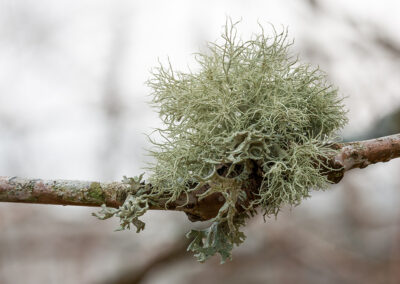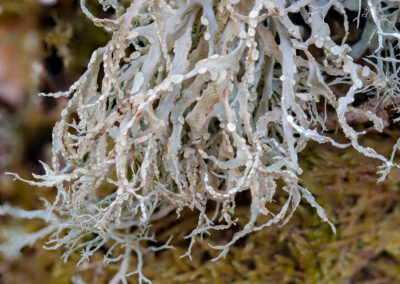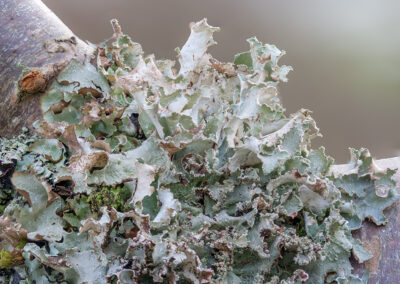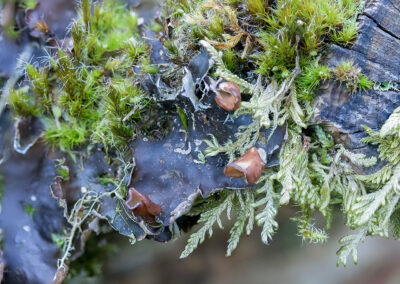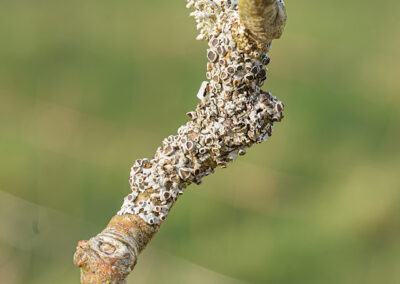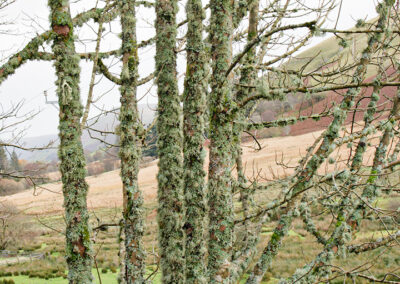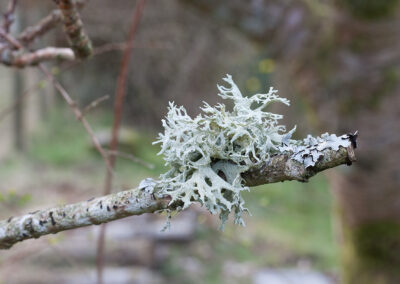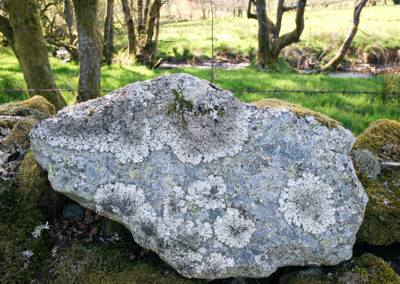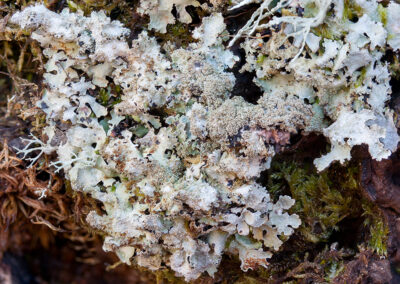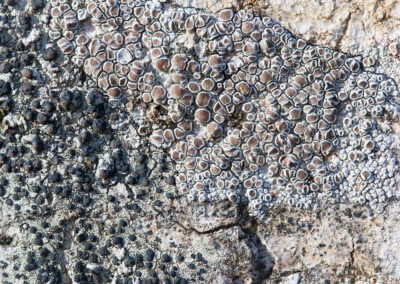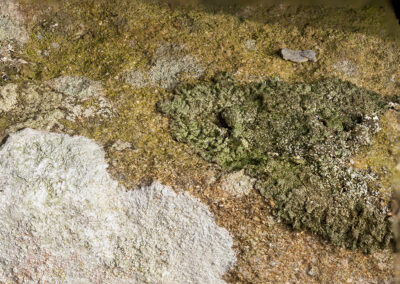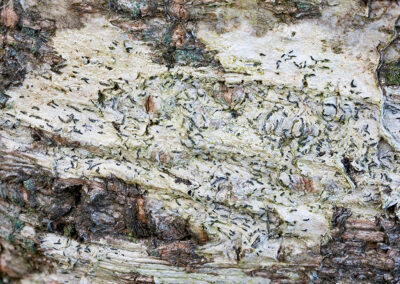Lichens
Although they are not technically plants (they’re a stable symbiotic association of a fungus and an alga and/or cyanobacterium), I have included them in this section of our website for convenience.
Lichens are usually all around us, wherever we are – city, country, grassy hills, damp woods, concrete pavement, rocky cliff faces, the seashore, Antarctica, even hot deserts – but are often unseen or ignored. They are sensitive to air pollution, so are scarcer in urban environments, where many of those present are of the ‘crustose’ form (see below). There are about 15,000 species worldwide, of which about 1,800 species live in the UK.
Wales is particularly rich in those species that grow in ancient woodlands, mostly on the trees; the coastal ‘Atlantic rainforest’ in Wales, Scotland and Ireland are some of the rarest habitats in the world, and are to be greatly valued and enjoyed. Dernol shares many of the species with these, not being short of damp weather itself, though does not have anything like the range of species of the more westerly woodlands.
Details of lichen structures, reproductive strategies and ecology are complex and very varied, so I will not go into any great depth here. There are plenty of online resources for further reading for anyone as fascinated by them as I am.
Lichens are composite organisms, with at least two separate species living symbiotically – a fungal body (the ‘mycobiont’) containing one or more algae, or more rarely cyanobacteria, (the ‘photobiont’). The fungal body (‘thallus’) protects the photobiont from drying out and partly shields it from UV light; for its part, the photobiont photosynthesises and provides nutrients for the fungus, as well as for itself.
Lichens have a three basic forms, though there are a few variants on these, which I will ignore here:
Crustose lichens’ thallus is crust-like; they are often seen on rocks and tree bark. Few rocks in Dernol do not have them.
Foliose lichens’ thallus has leaf-like lobes, and is attached to the substrate (mostly tree bark), usually by root-like rhizoids on its lower surface.
Fruticose lichens’ thallus is branched like small shrubs, and is attached to the substrate (usually tree bark) at its base (the ‘holdfast’).
Evernia prunastri (Oak Moss) & Hypogymnia tubulosa
Evernia prunastri (Oak Moss) & Hypogymnia tubulosa on Cherry tree in Glandernol garden
Reproduction in lichens can be either by spores or by vegetative means, and varies both within a species and between species.
Only the fungal partner reproduces sexually. Spore-producing fruiting bodies (‘apothecia’, ‘perithecia’ or ‘podetia’, depending on species) grow from the thallus, which, unlike the spore-producing bodies of other spore-producing plants, are often long-lived, producing large numbers of spores for several years. This is complicated in lichen as the spores are usually for the fungal part of the lichen only, and do not contain genetic material for the algal part; this means that after dispersal, before the spores can develop into a mature lichen they need to acquire their algal partner, which is usually very specific for each species i.e. not any alga will do.
Vegetative reproduction takes place via specialised structures on the surface of the lichen, which release small parts containing both the fungal and algal partners; these drop off, or can be wind-distributed, and can grow into new plants if they land somewhere suitable. There are two main types of vegetative propagation structures:
- ‘isidia’, which are outgrowths of the surface of the thallus, which contain the photobiont and are, unlike soredia, covered with the same cortex as the thallus.
- ‘soredia’, which are powdery or granular particles which grow on the surface of the thallus, and are photobiont cells wrapped in fungal filaments. Groups of soredia are known as ‘soralia’.
Examples of both isidia and soralia can be seen in some of the photos in the gallery above.
In 2018 I did an ‘Air Pollution Information System’ (APIS) survey of lichen in Dernol, selecting mature birch trees at the western end of the valley for survey.
APIS is a biomonitoring approach to environmental protection, in which ‘indicator species’ are identified. Lichens are an indicator species in that some of them are tolerant of some pollutants and some are not. For example, some species are tolerant of increased levels of atmospheric nitrogen or sulphur dioxide, some are not, and presence or absence of certain species in a location can be indicative of the levels of pollutants in the atmosphere. Changes to the prevalent species in a location can show that there have been changes to the levels of pollutants in the atmosphere. For example, in parts of Powys there have been changes downwind of factory chicken farms, with an increase in nitrogen tolerant species, and a decrease in those species that do not thrive on increased levels of nitrogen; this indicates that atmospheric levels of nitrogen (from the ammonia compounds released by these farms) are likely to have increased. So the lichens have acted like the ‘canary in the coalmine’, indicating that changes have occurred, which might be detrimental to many forms of life.
The lichens I found on the trees surveyed indicated that Dernol has a very low level of atmospheric pollution.



